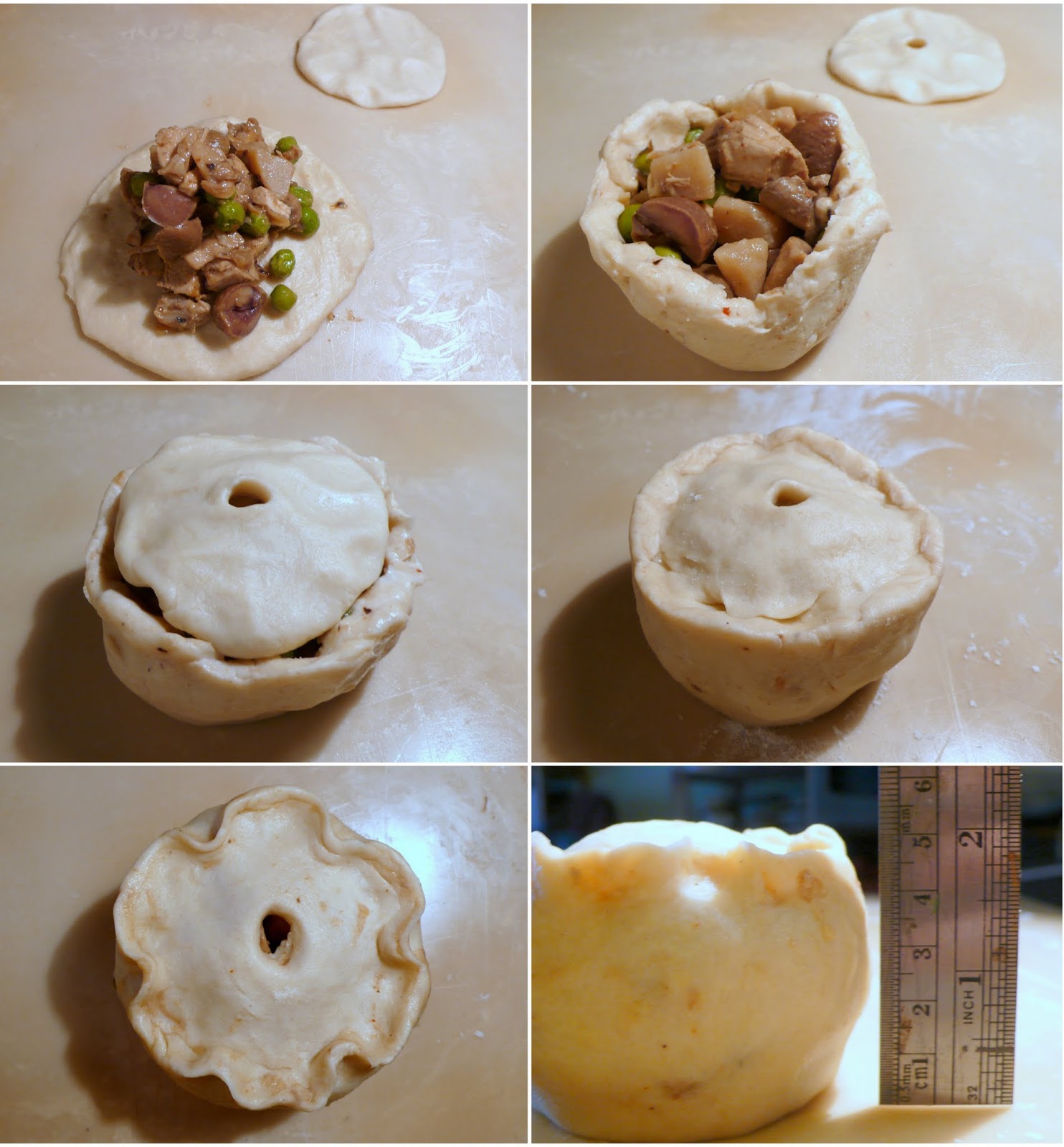| WHO WANTS PIE, RAISE YOUR HAND |
Hand-raised
pies have been on my to-do list for a while. These are pies that are
shaped by hand and not in a tin. Because they're unsupported when they bake, the sides drop slightly and expand outwards like a pot belly. Think Melton
Mowbray pies.
Now, there
are people out there who call their pies "hand-raised" even
though they are baked in a tin (often a deep muffin pan). I don't think that's completely accurate, although it does makes
the process simpler. But where's the fun in that?
Because
hand-raised pies bake without anything to hold them up, they need a strong shell
and that's where hot water crust pastry comes in. This is another
item that I've intended to try for some time. I haven't put it off
because it is difficult – it's not – but the
pastry has lard in it and that's not an ingredient I use in my
baking.
So I did some
reading and looked up several recipes, and found that vegetable
shortening or suet is also used. In terms of flavour, neither
ingredient can compete with lard, but I don't think it makes much
difference in the texture so that's a trade-off I'm willing to make.
I have used all shortening, all shredded suet (Atora brand) and a
combination of both, with good results for all alternatives.
So that's the
gravity-defying pastry sorted out.
Traditional hand-raised pies are often made with a wooden
pie dolly, which I don't have. Later, I found out a jam jar or drinking glass can be easily
employed as a substitute.
And
then I saw a
video where the pie maker didn't use any sort of utensil to
help shape the pie. He did it all by hand. I tried it and love it!
 |
| Hand-raising a pie |
The filling
for hand-raised pies is very often made with uncooked pork meat. This
means the filling can be pressed together in a tight ball which
doesn't come apart. That makes it easier to mould the hot water
pastry around it.
I have used a
cooked filling of cubed chicken, chestnuts, mushrooms, potato and frozen
peas (in hindsight, I should have left out the peas) which is
slightly looser in texture, and it is a bit fiddly to put together
but not impossible. I feel like I'm playing with modelling clay! Sculptors will probably know the feeling.
The sides of
my pies didn't brown thanks to my wayward oven (the name of this blog
wasn't chosen on a whim), but they were cooked properly
and didn't have the dreaded soggy bottoms. One of
these stout little pot-bellied pies makes the perfect portable lunch.
Makes 2 pies (about 7cm wide by 5cm high). Pastry based on Paul Hollywood's recipe.
100g plain flour
20g strong flour
25g butter
65ml boiling water
½ tsp salt
30g vegetable shortening or shredded suet, or a combination of both
1½ cups of cooked filling
1 egg, beaten, for egg wash
In a large mixing bowl, combine the flours then rub the butter in with your fingertips.
Mix together the boiling water, salt and shortening in a small saucepan. Heat and stir together until the shortening melts. Pour on top of the flour mixture, stirring with a spoon until everything comes together.
Tip the dough onto a work surface and knead briefly; bring together into a ball. It will be lumpy. Use the pastry while still warm.
Divide the pastry into two equal portions. From each half, remove a quarter of the pastry for the lids. Press out the lids into 6cm rounds and poke a small hole in the centre with a chopstick.
On a lightly floured surface, press out the remaining three-quarters of the pastry into two 13cm rounds. Place a mound of filling (about ¾ cups) in the centre of each round and press together to keep it together as much as possible (a stickier filling will stay together better).
Sculpt the pastry around the filling, trying as much as possible to make sure it is the same thickness all around and on the base. This is a bit fiddly, but can be done with some patience. Cup both hands under the edge of the pastry round and press it up tightly against the filling, building the sides straight up until the top of the filling. Don't worry if it isn't very neat at first. Rotate the pie on the floured surface with your palms to even out the sides and to make sure the filling is packed in, ensuring there are no holes in the pastry.
Brush a little water inside the rim of the pastry. Place the lid on top of the filling and press the edges of the pastry together to seal, with the rim slightly rising above the lid. Rotate the pie on the floured surface while pressing the sides gently – this will help tidy up its appearance and build up the height. Crimp around the top. If the hole has closed, use the chopstick to open it up again. Place pies on a lightly greased baking tray and refrigerate for about 20 minutes.
Meanwhile, preheat the oven to 200°C.
Brush the lids of the pies (not the crimp) with egg wash. Cook for 25-30 minutes, or until the pastry is nice and crisp all the way around.

Jane, I had never heard of this pie, but I already love it! So interesting that it is made without the support of a pan. It looks delicious as well.
ReplyDeleteMe too first time came across this kind of pie! I like the fat belly shape too:D Bet it's yummy as well!
ReplyDeleteI have never heard of this kind of pie, but I love it! I definitely want to try one of these! I love the gorgeous crimping you did on the edges, too!
ReplyDelete